Education and science01.09.2024
How Safi Utebayev University puts carbon neutrality principles into practice


Gulzada Shakulikova, Doctor of Economics, Professor, Rector of AOGU n.a. S. Utebayev
 Dana Kudassova, Candidate of Technical Sciences, MBA
Dana Kudassova, Candidate of Technical Sciences, MBA
Rinat Iskakov, Doctor of Chemical Sciences,Vice-Rector for Science and Innovation
In addition to major industrial enterprises, the country's leading universities are actively participating in the implementation of the strategy to reduce greenhouse gas emissions. Educational institutions conduct research on sustainable development and propose ideas for implementing the energy transition. In Kazakhstan, Atyrau University of Oil and Gas named after Safi Utebayev has been training specialists in the oil and gas sector for 65 years. The university, aware of its potential impact on the environment, is implementing several initiatives to reduce carbon dioxide emissions and train personnel responsible for achieving carbon neutrality in the future.
In 2023, Utebayev University conducted an energy audit of its infrastructure to identify the main energy sources, disadvantages and advantages of its current energy supply system, and to assess the potential fora gradual transition to zero carbon emissions within the university campus.
As a result of the monitoring, two main sources of carbon dioxide emissions arising from the activities of the university campus were identified. This is the consumption of natural gas for heating and water heating and the use of fuels and lubricants for vehicles and generator sets.
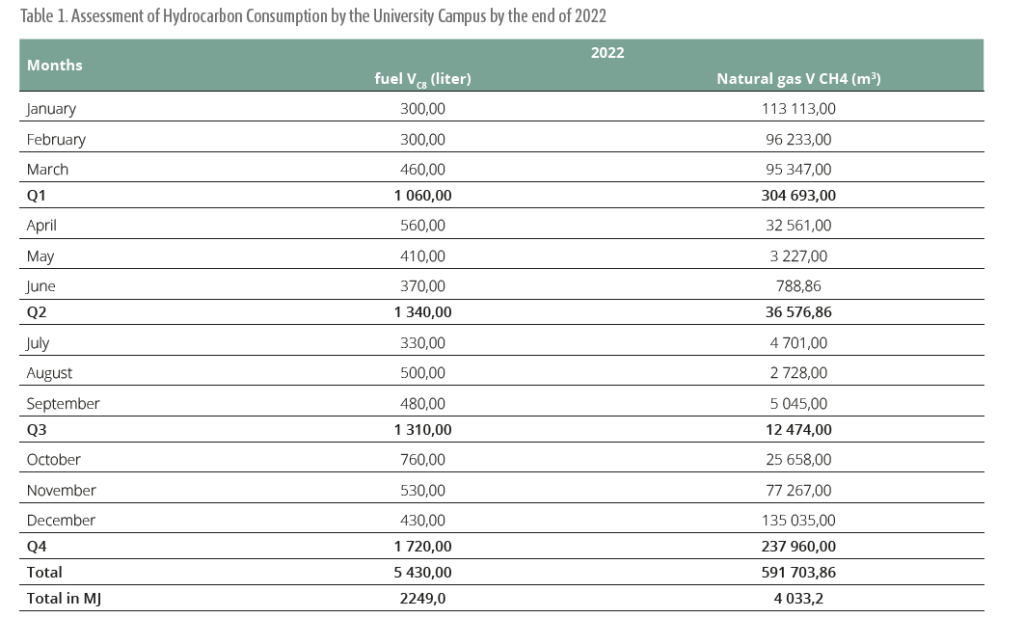
Thus, the volume of hydrocarbon emissions in 2022 from direct combustion of fuel by diesel generators and vehicles amounted to 157 tons and 1603.7 tons for housing heating systems. On average, heating of one standard campus building accounts for 145.5 tons of hydrocarbon emissions.
When converting energy into calories, the distribution strongly depends on the time of year based on the type of energy. For example, in winter, the share of gas consumption increases significantly, and in summer, electricity and fuel (fuels and lubricants) are used significantly more.
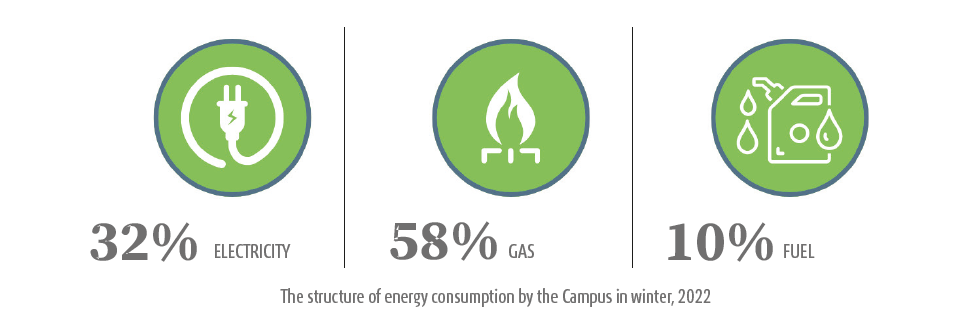
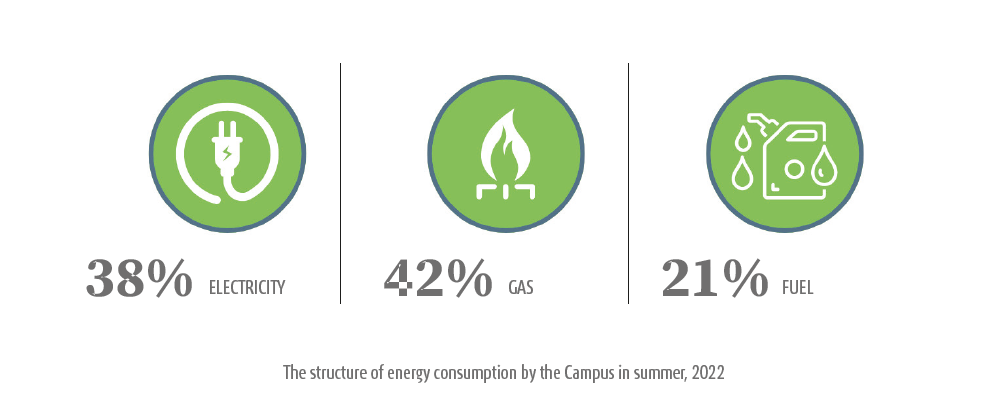
INSTRUMENTS FOR STEP-BY-STEP ENERGY CONVERSION
In order to implement the Roadmap for the energy transformation of the university campus and the transition to carbon-neutral technologies, a concept for the phased conversion of buildings to alternative energy sources, in conjunction with energy-saving measures, was approved.
In particular, based on the specific needs of the university, the following energy-saving measures were taken:
- Motion sensor lamps have been installed in rooms without natural lighting;
- In rooms with moderate natural light, a combined solution has been used: torch lamps and lamps with light sensors, depending on the room;
- In rooms with full natural light, lamps with light sensors have been installed.
According to preliminary calculations, savings can reach 123,500 kWh of electricity. If we take into account current electricity consumption, which is up to 737,300 kilowatt-hours, the savings would amount to 16.8 percent. At the current electricity price, this will comprise 5,684,500 tenge per year.
Together with voltage stabilization by reducing reactive current, the total annual energy savings will amount to 123,500 x 1,125 = 139,000 kWh, or 6,391,000 tenge.
Table 2 shows the schedule of the energy transformation project until 2033, which will allow the university to achieve its goal of reducing energy consumption and harmful emissions, as well as outline the main stages and their anticipated outcomes.
During the first year, the main efforts will be focused on the implementation of energy-saving instruments throughout the campus infrastructure. At the same time, from the beginning of the project until its completion, the building will undergo a consistent renovation with the transfer of heating systems from natural gas to alternative energy sources.
In 2026, 2028,2029 and 2030, respectively, both car engines (C1 and C2) and diesel generators (G1 and G2) will be replaced with hybrid/electric cars and renewable energy sources.
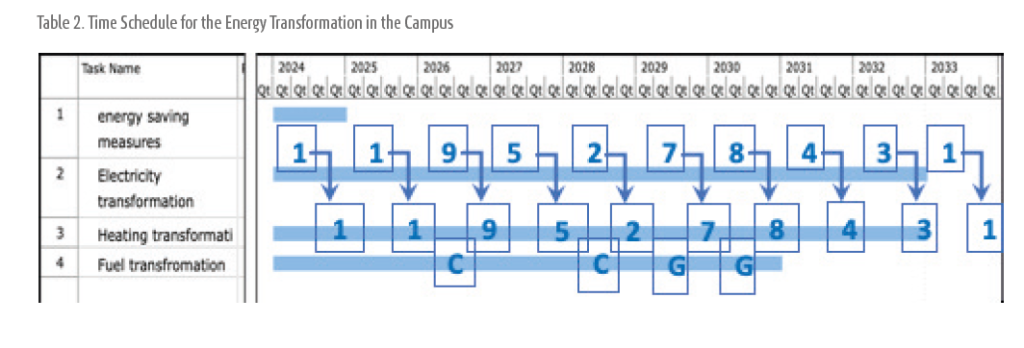
The feasibility study of the project indicates that, although there is a requirement for substantial initial investments in the energy transition, savings from utilizing own generated energy sources will commence after five years of transformation.
Therefore, the cash flow curve for spending funds on the implementation of the Roadmap presented in Fig.2 reflects the cumulative values of saving costs for external energy by increasing the base of own energy generation sources.
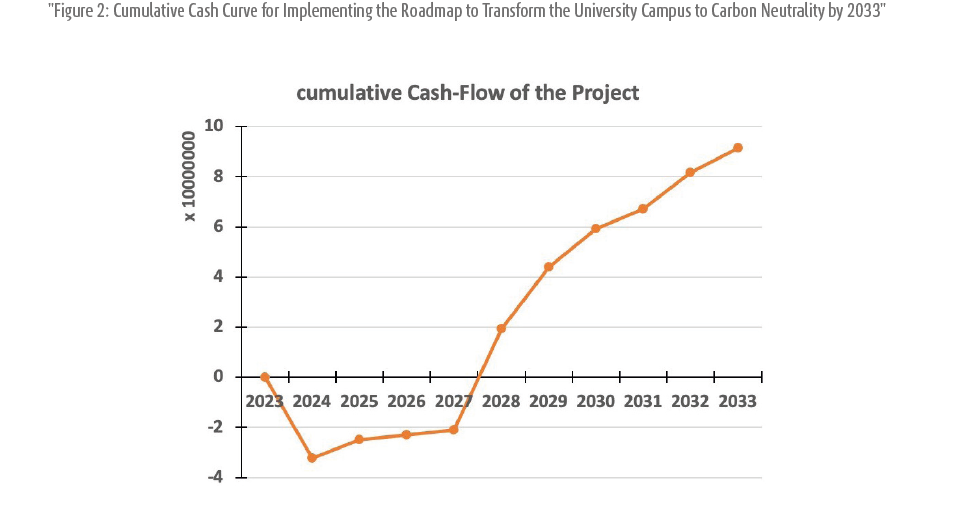
Table 3 demonstrates the main indicators classified into four different types of clusters, such as Energy and Carbon, Water
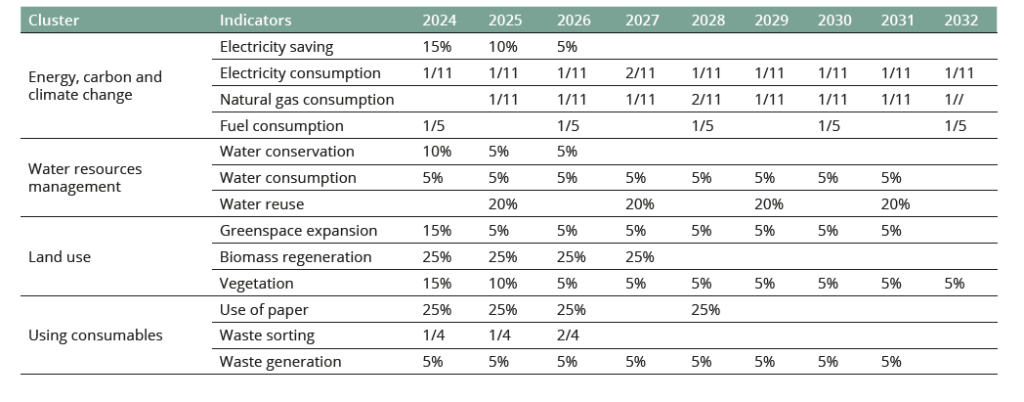
A detailed description of all figures and indicators is provided below:
1. Energy, Carbon Emissions and Climate Change
A. Electricity saving is presented as a decrease in the percentage of total consumption compared to the previous year.
B. Electricity consumption is shown as the amount of the entire infrastructure converted to alternative energy production.
C. Natural gas consumption is reflected as the amount of the entire infrastructure converted to alternative energy sources.
D. Fuel consumption is shown as the number of vehicles that have been converted to hybrid or electric models, or the number of diesel engines that have been switched to renewable energy sources.
2. Water Resources Management
A. Water conservation is indicated as a decrease in the percentage of total use compared to the previous year.
B. Water consumption is shown as a decrease in the percentage of total consumption compared to the previous year.
C. Water reuse is shown as an increase in the percentage of rainwater used for plant irrigation compared to the previous year.
3. Land Use
A. Green surfaces are shown as an increase in the percentage of land used for lawns and vegetation.
B. Biomass regeneration is shown as an increase in the percentage of biomass used either for plant purposes or for the production of green gas.
C. Vegetation is shown as an increase in the percentage of plants and trees compared to the previous year.
4. Utilization of Materials
A. The use of paper is shown as a decrease in the percentage of paper use compared to the previous year.
B. Waste sorting is shown as an increase in the number of sorted types of waste.
C. Waste generation is shown as a decrease in the percentage of solid waste compared to the previous year.
GREEN TRANSFORMATION
Therefore, the university has not only committed to adopting ESG standards but is also taking steps to transform its campus towards achieving zero hydrocarbon emissions in the future. In confirmation of the efforts undertaken, it is worth noting that in the 2023-2024 academic year, 29 graduation projects of students were devoted to the implementation of practical steps for the energy transformation of the university campus. This year, the university's first infrastructure renovation was conducted with consideration to transitioning towards energy conservation and the efficient utilization of alternative energy sources.
Despite its history in hydrocarbon development and specialist training for the industry, Atyrau University of Oil and Gas named after Safi Utebayev forms the competencies of sustainable development for a new generation of oil and gas industry professionals, encouraging them to take responsibility for the future green well-being of the country.
‘Wings’ on poles: Bill Gates-backed breakthrough wind turbine facility breaks ground
Perovskite tandem solar cell achieves new efficiency record
Kazakhstan and China endorse draft SCO joint statement on sustainable energy development
Innovative research on organic solar cells for space applications
Kazakhstan and Uzbekistan drive green energy progress in Central Asia
KazMunayGas launches pilot green hydrogen project in Atyrau
How private homeowners in Kazakhstan can make money from solar panels
14 countries are investing in Kazakhstan's renewable energy sector through auctions
How green hydrogen could transform Kazakhstan’s energy sector
IKEA offers ready-to-use solar power systems for balconies
Adani commissions India’s first off-grid green hydrogen pilot plant
Tajikistan unveils green energy roadmap at international conference in Dushanbe
Hydropower projects selected through KOREM Auction in Kazakhstan
EU reaches political deal to simplify CBAM
New research could unlock the potential of bladeless wind turbines
Uzbekistan to launch 16 renewable energy facilities by the end of 2025
Kazakhstan holds auction for 50 MW of small hydropower projects
Kazakhstan and EBRD strengthen partnership on decarbonisation and renewable energy
$200 million solar energy complex breaks ground in Egypt
Official report revealed causes of Spain's blackout











